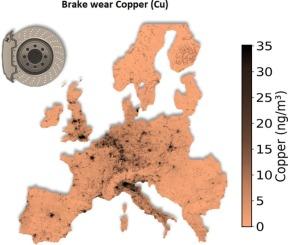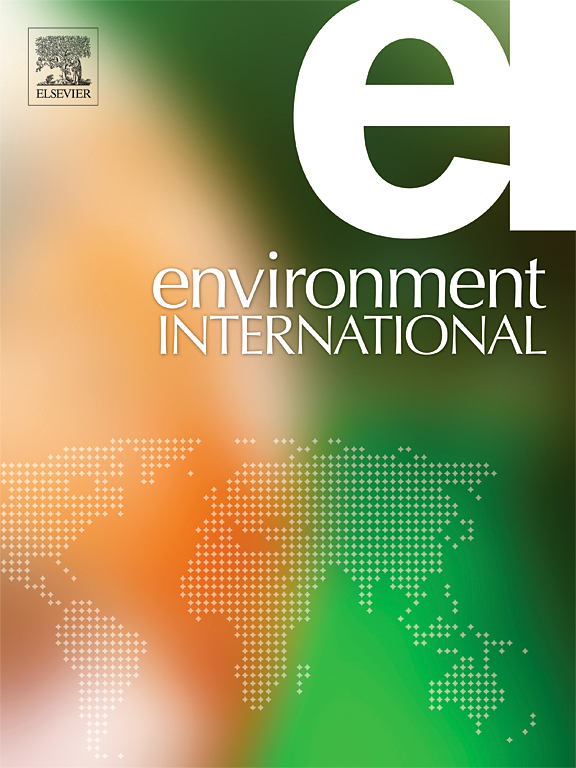欧洲上空颗粒物化学成分的高分辨率模型:刹车磨损污染
IF 9.7
1区 环境科学与生态学
Q1 ENVIRONMENTAL SCIENCES
引用次数: 0
摘要
在当今快速发展的社会中,大气颗粒物(PM)排放的来源正在发生重大变化。对车辆尾气排放的严格规定,加上缺乏对非排气车辆排放的控制,导致欧洲非排气PM的相对贡献增加。本研究通过模拟高空间分辨率为~ 250 m的铜(Cu)浓度,分析了整个欧洲制动磨损PM污染的空间分布、时间趋势和影响,铜(Cu)浓度是制动磨损排放的关键示踪剂。我们将CAMx化学运输模型中的粗分辨率刹车磨损Cu和高分辨率土地利用数据整合到随机森林模型中,以预测整个欧洲大陆250 m的Cu浓度。随机森林模型的训练使用了一个前所未有的数据集,该数据集来自152个地点,每天测量超过50,000个铜。它修正了CAMx的低估,并将Cu缩小到更高的空间分辨率。在验证中,该模型具有良好的时空预测能力,Pearson相关系数分别为0.6和0.7。我们生成了欧洲10 年(2010-2019年)的每日铜浓度,揭示了与城市化和道路网络相一致的空间格局,城市达到峰值,农村地区较低。时间趋势表明,铜浓度一般在工作日和冬季达到峰值。尽管几十年来欧洲的PM有所下降,但从2010年到2019年,许多城市的Cu浓度没有下降。铜水平与人口密度密切相关,超过1200万欧洲人接触到的铜水平超过40 ng/m3,相当于刹车磨损产生的总PM10约1 μg/m3。我们的研究结果强调,需要扩大非排气示踪剂的金属测量,以便更好地了解包括Cu在内的PM成分与健康的关系,以及更有效地规定EURO 7车辆中的非排气PM排放。本文章由计算机程序翻译,如有差异,请以英文原文为准。


High-resolution modelling of particulate matter chemical composition over Europe: brake wear pollution
In today’s rapidly evolving society, the sources of atmospheric particulate matter (PM) emissions are shifting significantly. Stringent regulations on vehicle tailpipe emissions, in combination with a lack of control of non-exhaust vehicular emissions, have led to an increase in the relative contribution of non-exhaust PM in Europe. This study analyzes the spatial distribution, temporal trends, and impacts of brake wear PM pollution across Europe by modeling copper (Cu) concentrations at a high spatial resolution of ∼250 m which is a key tracer of brake-wear emissions. We integrated coarse-resolution brake-wear Cu from CAMx chemical transport model and high-resolution land use data into a random forest (RF) model to predict Cu concentrations at ∼250 m over whole of continental Europe. The RF model was trained using an unprecedented dataset of over 50,000 daily Cu measurements from 152 sites. It corrected CAMx underestimation and downscaled Cu to a higher spatial resolution. In validation, the model showed robust spatial and temporal prediction with good Pearson’s correlation coefficients of 0.6 and 0.7, respectively. We generated 10 years (2010–2019) of daily Cu concentrations over Europe, revealing spatial patterns aligned with urbanization and road networks, with peaks in cities and lower values in rural areas. Temporal trends reveal that Cu concentrations generally peak on weekdays and in winter. Despite a decline in PM across Europe over decades, Cu concentrations showed no decrease in many cities from 2010 to 2019. Cu levels are strongly correlated with population density with more than 12 million Europeans exposed to levels exceeding 40 ng/m3, equivalent to around 1 μg/m3 of total PM10 from brake wear. Our findings highlight the need for expanded metal measurement for non-exhaust tracers for a better understanding of the health relevance of PM composition including Cu, and more effective regulations of non-exhaust PM emissions as included in EURO 7 vehicles.
求助全文
通过发布文献求助,成功后即可免费获取论文全文。
去求助
来源期刊

Environment International
环境科学-环境科学
CiteScore
21.90
自引率
3.40%
发文量
734
审稿时长
2.8 months
期刊介绍:
Environmental Health publishes manuscripts focusing on critical aspects of environmental and occupational medicine, including studies in toxicology and epidemiology, to illuminate the human health implications of exposure to environmental hazards. The journal adopts an open-access model and practices open peer review.
It caters to scientists and practitioners across all environmental science domains, directly or indirectly impacting human health and well-being. With a commitment to enhancing the prevention of environmentally-related health risks, Environmental Health serves as a public health journal for the community and scientists engaged in matters of public health significance concerning the environment.
 求助内容:
求助内容: 应助结果提醒方式:
应助结果提醒方式:


